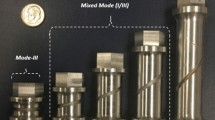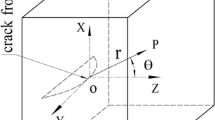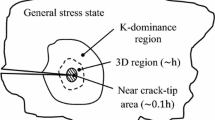Abstract
The method of Coherent Gradient Sensing (CGS) in transmission, in conjunction with two and three dimensional finite element methods, is used to study the effect of mode mixity on crack tip stress fields. Using a two dimensional finite element analysis the outer bounds of the region of K-dominance were determined. A three dimensional finite analysis was utilized to study the effect of mode mixity on the three dimensional nature of the stress field in the immediate vicinity of the crack tip and to obtain an inner bound of the region of K-dominance. It was noted that increasing mode mixity leads to an increased rotation of the three dimensional zone, keeping its shape and size unchanged. In contrast, the region of K-dominance is seen to dramatically depend on mode mixity, both in shape and size. In addition, an analysis of the CGS interferograms was conducted to obtain an estimate of the regions of K-dominance experimentally. A least squares fit data analysis technique was used to extract fracture parameters, namely the stress intensity factors K I, K II and subsequently the crack tip phase angle, φ. The data points used for the least square fitting were obtained from the determined regions of K-dominance. The same fracture parameters were also evaluated from the finite element analysis, and good agreement was found between experimental measurements and finite element predictions.
Similar content being viewed by others
References
ABAQUS fracture mechanics lecture notes. Hibbitt, Karlsson, Sorensen, Inc. (1997).
Asp, L.E. (1998). The effects of moisture and temperature on the interlaminar delamination toughness of carbon/epoxy composite. Composites Science and Technology 58, 967–977.
Broberg, K.B. (1999). Cracks and Fracture, Academic Press, San Diego.
Chao, Y.J. and Liu, S. (1997). On failure of cracks under mixed-mode loads. International Journal of Fracture 87, 201–223.
Chiang, F.P. and Hareesh, T.V. (1988). 3-dimensional crack tip deformation - An experimental study and comparison to HRR field. International Journal of Fracture 36, 243–257.
Dhirendra, V.K and Narasimhan, R. (1998). Mixed-mode steady-state crack growth in elastic-plastic solids. Engineering Fracture Mechanics 59, 543–559.
Erdogan, F. and Sih, G.C. (1963). On crack extension in plates under plane loading and transverse shear. ASME Journal of Basic Engineering 85D, 519–527.
Kalthoff, J.F. and Winkler, S. (1987). Failure mode transition at high rates of shear loading. Impact Loading and Dynamic Behaviour 1, 185–195.
Krishnaswamy, S., Rosakis, A.J. and Ravichandran, G. (1991). On the extent of dominance of asymptotic elastodynamic crack-tip fields: Part II-Numerical investigation of three dimensional and transient effects. Journal of Applied Mechanics 58, 95–103.
Lee, Y.J. and Freund, L.B. (1990). Fracture initiation to asymmetric impact loading of an edge cracked plate. Journal of Applied Mechanics 57, 104–111.
Mahajan, R.V. and Ravi-Chandar, K. (1989). An experimental investigation of mixed mode-mode fracture. International Journal of Fracture 41, 235–252.
Mason, J.J., Lambros, J. and Rosakis, A.J. (1992). The use of coherent gradient sensor in dynamic mixed-mode fracture mechanics experiments. Journal of Mechanics and Physics of Solids 40, 641–661.
Narasimhan, R. and Rosakis, A.J. (1988). Three-dimensional effects near a crack tip in a ductile three point bend specimen. Part I: Numerical Analysis. Journal of Applied Mechanics 57, 607–617.
Nigam, H. and Shukla, H. (1988). Comparison of the techniques of transmitted caustics and photoelasticity as applied to fracture. Experimental Mechanics 28, 123–135.
O'Dowd, N.P., Shih, C.F. and Stout, M.G. (1992). Test geometries for measuring interfacial fracture toughness. International Journal of Solids and Structures 29, 571–589.
Ramaswamy, S., Tippur, H.V. and Xu, L. (1993). Mixed-mode crack-tip deformations studied using a modified flexural specimen and coherent gradient sensing. Experimental Mechanics 33, 218–227.
Rice, J.R. (1968). A path independent integral and the approximate analysis of strain concentration by notches and cracks. Journal of Applied Mechanics 35 379–386.
Rosakis, A.J. (1993). Two Optical Techniques Sensitive to Gradients in Optical Path Difference: The Method of Caustics and the Coherent Gradient Sensor (CGS) In: Experimental Techniques in Fracture (Edited by Epstein, J.S.), VCH Publishers Inc., New York, pp. 327–425.
Rosakis, A.J. and Ravi-Chandar, K. (1986). On crack tip stress state: An experimental evaluation of threedimensional effects. International Journal of Solids and Structures 22, 121–134.
Royer, J. (1988). Study of pure and mixed-mode fracture of a brittle material. Experimental Mechanics 28, 382–387.
Sinha, J.K., Tippur, H.V. and Xu, L. (1987). An interferometric and finite element investigation of interfacial crack tip fields: role of mode-mixity on 3-D stress variations. International Journal of Solids and Structures 34, 741–754.
Sundararaman, V. and Davidson, B.D. (1988). An unsymmetrical end-notched flexure test for Interfacial fracture toughness determination. Engineering Fracture Mechanics 60, 361–377.
Tippur, H.V. and Ramaswamy, S. (1993). Measurement of mixed-mode fracture parameters near cracks in homogeneous and bimaterial beams. International Journal of Fracture 61, 247–265.
Tippur, H.V., Krishnaswamy, S. and Rosakis, A.J. (1991). A coherent gradient sensor for crack tip measurements: Analysis and experimental results. International Journal of Fracture 48, 193–204.
Williams, M.L. (1959). On the stress distribution at the bast of a stationary crack. Journal of Applied Mechanics 24, 109–114.
Author information
Authors and Affiliations
Rights and permissions
About this article
Cite this article
Prabhu, S., Lambros, J. Effect of mode mixity on K-dominance and three dimensionality in cracked plates. International Journal of Fracture 104, 51–69 (2000). https://doi.org/10.1023/A:1007653105374
Issue Date:
DOI: https://doi.org/10.1023/A:1007653105374




